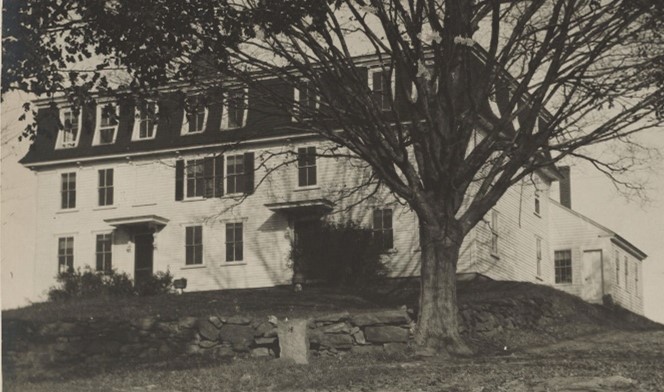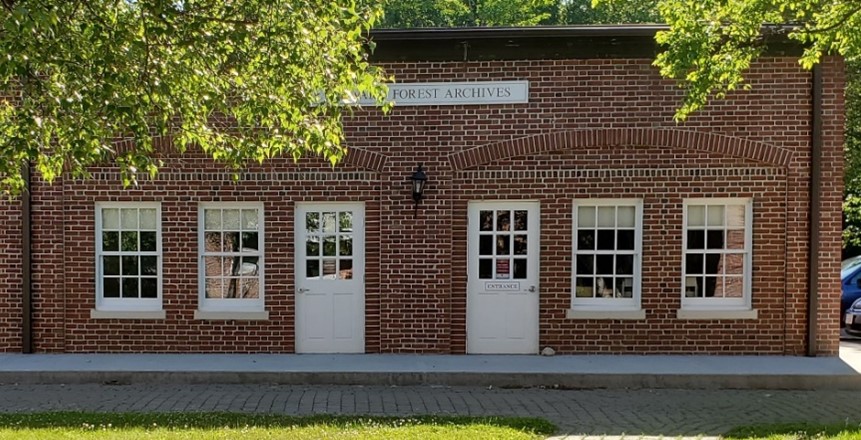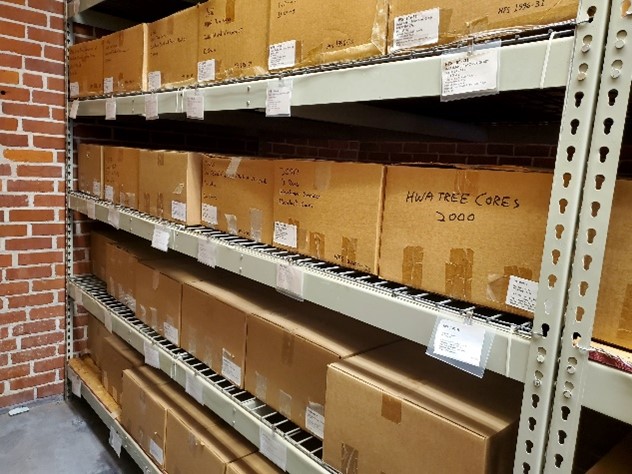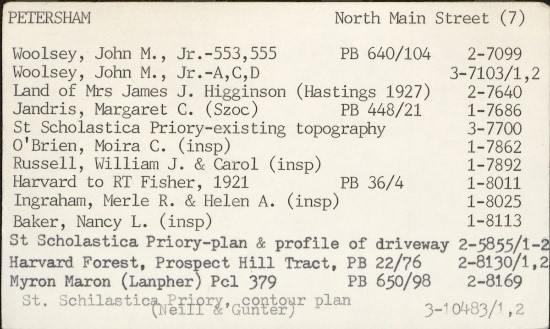You are here
History of the Harvard Forest Archives

Harvard Forest Archive
Harvard University’s Forestry program began in 1903 under the direction of R. T. Fisher. It was first part of the Lawrence Scientific School and courses were taught in Cambridge classrooms. In 1907, gifts from generous donors made possible the acquisition of about 2000 acres of land in Petersham for the creation of a field-based classroom for Harvard’s Forestry students. The Harvard Forest was founded that year with R. T. Fisher as its first director and students began working there the following year. At first it was used only as a field laboratory and demonstration tract while classes continued in Cambridge. Then in 1923 the Harvard Forest became the center of instruction and students began spending the academic year living and working at the Forest.
 From the very beginning, Harvard Forest directors and researchers recognized the value of documenting the work of the researchers and the importance of protecting that data. The original headquarters was the old wooden farmhouse, so irreplaceable documents were placed in a vault at the Athol Savings Bank for safekeeping. Later, the owner of Plotkin Furniture Company in Athol loaned the Harvard Forest a fireproof room in their warehouse to store those records. In 1938 some of those records were moved temporarily into the newly built brick garage behind the future location of the new Harvard Forest headquarters. When the new headquarters building was completed in 1940 all of the records were moved into its fireproof vault.
From the very beginning, Harvard Forest directors and researchers recognized the value of documenting the work of the researchers and the importance of protecting that data. The original headquarters was the old wooden farmhouse, so irreplaceable documents were placed in a vault at the Athol Savings Bank for safekeeping. Later, the owner of Plotkin Furniture Company in Athol loaned the Harvard Forest a fireproof room in their warehouse to store those records. In 1938 some of those records were moved temporarily into the newly built brick garage behind the future location of the new Harvard Forest headquarters. When the new headquarters building was completed in 1940 all of the records were moved into its fireproof vault.
Eventually, the vast collection of research, images and maps outgrew the space in the vault so in 1994 part of the brick garage was converted into Harvard Forest’s Archive. Three bays were turned into rooms that are climate controlled for consistent temperature and optimal humidity levels. One room is used as an office and workspace for the Archive staff. A second room contains research files comprising over 100 years’ worth of data collected by Harvard Forest researchers including manuscripts, reports, theses, and the highly detailed stand records and records of operations that have taken place on the Harvard Forest tracts since 1908. There are also materials related to the history of the Harvard Forest, the history of Petersham, the Quabbin Reservoir, and the 1938 hurricane. The third room houses the map collection; an extensive collection of lantern slides, historical and aerial photographs; plus, correspondence and other administrative records.

The process by which the volumes of documents, images and data are cataloged and made searchable has grown increasingly sophisticated over the years. The first searchable systems utilized punch cards. In 1988, Harvard Forest’s Information Management System was developed and the archival collections, still in the Shaler Hall vault, were formally physically curated. By 1993 computerized databases of Archive documents (research publications, unpublished studies and maps) were created. A major step in making the collections even more searchable and shareable started in 2007 with funding from Harvard University’s Library Digital Initiative (LDI). As part of the LDI project, approximately 33,000 pages of stand records and forest operations and about 350 negatives, photographs and glass lantern slides were digitized, and a catalog was created using ProCite. The scanned images along with more recently scanned and digitally-born images now can be accessed through Harvard Forest’s PhotoShelter Galleries.
 The online Archive Catalog in use today was completed in 2012. It allows users to search the Archive's collection of maps, research files and samples, images, and administrative records. Some catalog records also contain links to digital materials such as datasets in the Harvard Forest Data Archive, an online repository of scientific data collected at the Harvard Forest; publications in the Harvard Forest Bibliography, the online database of publications related to the Harvard Forest; and images in Harvard Forest’s PhotoShelter galleries. The digitized stand records and forest inventories are available to view online through Harvard’s Mirador Viewer. A collaboration with Digital Commonwealth, a website managed by the Boston Public Library which provides online access to cultural heritage records held by Massachusetts institutes, led to the digitization of over 600 maps from the Harvard Forest Map Collection.
The online Archive Catalog in use today was completed in 2012. It allows users to search the Archive's collection of maps, research files and samples, images, and administrative records. Some catalog records also contain links to digital materials such as datasets in the Harvard Forest Data Archive, an online repository of scientific data collected at the Harvard Forest; publications in the Harvard Forest Bibliography, the online database of publications related to the Harvard Forest; and images in Harvard Forest’s PhotoShelter galleries. The digitized stand records and forest inventories are available to view online through Harvard’s Mirador Viewer. A collaboration with Digital Commonwealth, a website managed by the Boston Public Library which provides online access to cultural heritage records held by Massachusetts institutes, led to the digitization of over 600 maps from the Harvard Forest Map Collection.
Harvard Forest Sample Archive

The Harvard Forest Sample Archive was developed in 1993. The goals of the Sample Archive included preservation and electronic cataloging of the over 32,000 soil and plant tissue samples which were stored in various locations and preventing potentially useful samples from being discarded due to storage limitations. Research samples are now housed in three climate-controlled bays.
Berry Engineering Archive
 The most recent addition to the Archives came in 2017 when the Harvard Forest acquired the records collection of Berry Engineering, a land surveying and civil engineering company located in Petersham that serviced the local area for nearly half a century. The company’s collection of surveys, maps, plans, deeds, and field notes is housed in its own climate-controlled bay. The index cards used to locate materials in the collection were digitized and are now available to view online through Harvard Library’s ListView.
The most recent addition to the Archives came in 2017 when the Harvard Forest acquired the records collection of Berry Engineering, a land surveying and civil engineering company located in Petersham that serviced the local area for nearly half a century. The company’s collection of surveys, maps, plans, deeds, and field notes is housed in its own climate-controlled bay. The index cards used to locate materials in the collection were digitized and are now available to view online through Harvard Library’s ListView.
The Harvard Forest Library
 The Harvard Forest Library contains texts and periodicals that support ongoing research and document the history of forests and forestry in eastern North America. The Harvard Forest headquarters was built with a 4-story library. In 1964, an experienced librarian reorganized the entire contents of the library and started a cataloging system using index cards. By 1980 the library was using key punched citation cards for each item in the library. That year, the library shifted to a computer system to develop and print the catalog and produce alphabetized lists by author, title, or keyword. This also allowed duplication of the catalogs so that copies could be kept in Petersham and shared elsewhere. In 1983 a specialized program was written to enable the Harvard Forest’s microcomputer to create a catalog of the library holdings which could be printed out alphabetically by author or title or keywords. In 2004, the contents of the library were formally curated and digitally entered into the Harvard University HOLLIS library system by Harvard librarians. In 2015 The original 4-story library was converted to a conference room, offices, and storage space and its contents relocated to a climate-controlled space in another part of the building. Note: the library is for use by Harvard Forest researchers only and materials do not circulate.
The Harvard Forest Library contains texts and periodicals that support ongoing research and document the history of forests and forestry in eastern North America. The Harvard Forest headquarters was built with a 4-story library. In 1964, an experienced librarian reorganized the entire contents of the library and started a cataloging system using index cards. By 1980 the library was using key punched citation cards for each item in the library. That year, the library shifted to a computer system to develop and print the catalog and produce alphabetized lists by author, title, or keyword. This also allowed duplication of the catalogs so that copies could be kept in Petersham and shared elsewhere. In 1983 a specialized program was written to enable the Harvard Forest’s microcomputer to create a catalog of the library holdings which could be printed out alphabetically by author or title or keywords. In 2004, the contents of the library were formally curated and digitally entered into the Harvard University HOLLIS library system by Harvard librarians. In 2015 The original 4-story library was converted to a conference room, offices, and storage space and its contents relocated to a climate-controlled space in another part of the building. Note: the library is for use by Harvard Forest researchers only and materials do not circulate.
For more information about the Harvard Forest Archives, please contact Julie Hall, Archives Assistant at hflib@fas.harvard.edu.
Image descriptions, in order of appearance:
Harvard Forestry students cutting trees and making a stem analysis in the Tom Swamp Tract, 1908.
The original Harvard Forest Headquarters, now known as the Community House.
The present-day Harvard Forest Archive building.
The Harvard Forest Archive map room.
Research samples.
A scanned index card from the Berry Engineering collection.
- The present-day Harvard Forest Library.

